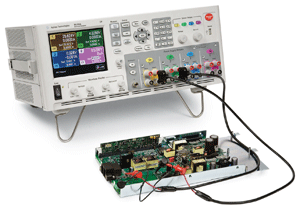A new kind of instrument: N6705A dc power analyzer
In May 2004, Agilent Technologies (www.agilent.com) introduced the N6700 series modular, programmable power supply system. Referred to internally as “The Pizza Box” because of its rack-wide, rack-deep, 1U- high dimensions, it was designed for the production–ATE market an environment where control would be relegated to software and human interaction with the instrument would be minimal. Thus the system interfaces were designed for computers, not people.
The programmable supply was an unqualified ATE success, but Agilent’s sales force began to hear two requests from customers: one was for more power, the other was for a benchtop version. The supply’s modular nature made satisfying the first request easier, and in a year higher-powered modules were out, but the second was more challenging.
At Agilent, product development is a three-part process. One part rests in the hands of the Product Planning Manager, whose job it is to work with customers and potential customers to find out what they really need. Then a Product Manager works with product planing to define a set of product requirements, and then enlists an R&D Project Manager to develop the technologies needed to fulfill the requirements. The Agilent team of Product Planning Manager Jim Stanko Product Manager Bob Zollo, and Project Manager Rick Carlson tackled the second request.

It was clear that, for a benchtop version, the Pizza Box should be folded up, trading low profile for a bench-friendly footprint. Had the work stopped here, the N6705A might just have been another benchtop supply. But Agilent had just put Dave Long a key developer of Agilent’s Infiniium scopes in charge of R&D. In early 2005, he suggested, “Why not give the system a new user interface?” This sparked the dc power analyzer’s innovation.
The team set out to create an “instrument personality” with the feel of all the instruments the analyzer could be: a DMM, scope, arb waveform generator, and a datalogger. This involved considerable UI design work, enlisting the aid of internal usability experts and testing with engineers outside the project. The interface is truly “intuitive” because it reflects a broad consensus, not just one person’s ideas.
Richard Comerford
Advertisement
Learn more about Agilent Technologies





